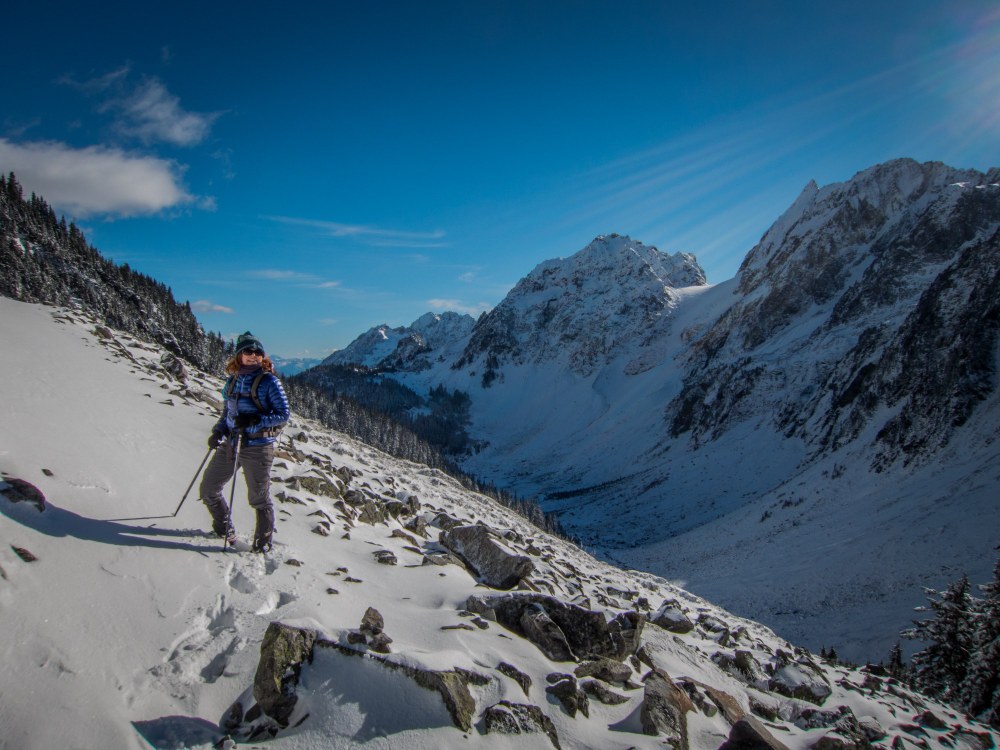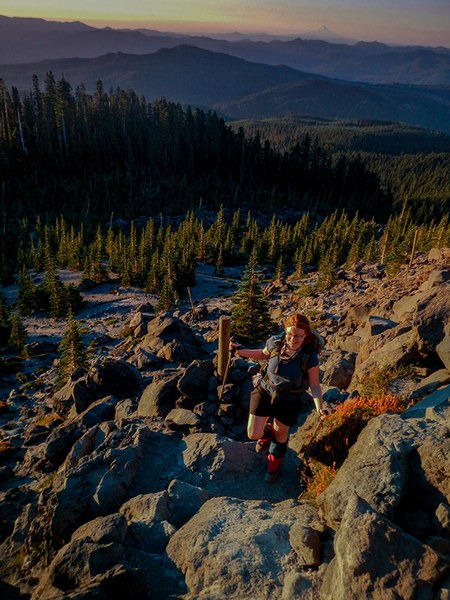
Sarah Lange is an outdoor recreation planner for the U.S. Forest Service. She’s also a former Mountaineers staff member, working as the Public Lands Program Manager from 2010-2013. At the 2017 Mountaineers Leadership Conference, Sarah was part of a land manager and partners panel and discussed ways that Mountaineers leaders can integrate stewardship and low-impact recreation into their trips and activities. Heading into the busy summer season, I caught up with Sarah to better understand her perspective as a land manager, and to learn more about how our leaders can encourage and inspire others to be responsible stewards of our public lands.
What sparked your interest in outdoor recreation and when did you become particularly interested in the stewardship of our public lands?
I’ve enjoyed playing outside ever since I was a kid, but I came into a career centered on outdoor recreation more or less by accident. Right out of college I worked for a national wildlife refuge on the coast of North Carolina, where I purchased a used sea kayak and began exploring the coastal waterways of the Outer Banks. When my temporary job at the refuge came to an end, I did a nationwide search for environmentally focused work and applied for an AmeriCorps position at Washington Water Trails Association (WWTA). I took the short-term job, eager for an excuse to build my sea kayaking skills and gain exposure to the Pacific Northwest. At the time, I was skeptical about the importance of trails and public access relative to other conservation issues. I ended up spending the next five years at WWTA getting familiar with the intricacies of public land management, engaging with volunteers in stewardship and trail planning, and studying and teaching outdoor ethics. It was during that time that I came to understand that exposure and access to the outdoors are vital if we want to keep conservation relevant to a changing society, and I developed a deep interest in recreation management.
What is your current role with the U.S. Forest Service (USFS), and how has that influenced your perspective on the importance of good stewardship?
I currently work in recreation and protected area management for Mt. Baker-Snoqualmie National Forest. Among other things, I lead a long-term management planning process for the Middle Fork and Pratt Wild and Scenic rivers, support the forest’s efforts to modernize outfitting and guiding policies, and advise on recreation-related research projects. My work puts me in touch with so many different resources and values on the forest, such as tribal treaty rights, wildlife habitat, water quality, and forest products. More than ever, I’m aware that our national forests are more than just beautiful places to play and enjoy nature. This sense of the bigger picture definitely influences how I think about stewardship and the role of personal responsibility outdoors. Stewardship of the land is inherently good, but when you consider the sheer volume of visitors to our popular destinations in the forest, it becomes even more critical.
How can our leaders incorporate more stewardship practices into their activities?
Mountaineers leaders have the unique opportunity to facilitate dialogues about best practices for low-impact recreation and set expectations for how groups will approach cross-country travel, what they will do with their waste and food storage, how they will handle wildlife encounters — skills like that. Beyond the very important role of establishing outdoor ethic “norms” among trip members, there are always opportunities to leave a place a little better than you found it.
Writing up a gear list for your trip? In addition to the Ten Essentials, ask everyone to bring a small trash bag and hold a contest for the most unique piece of trash packed out. The winner gets a granola bar, or something much tastier. If you see something that needs attention — a vandalized sign, overflowing toilet, washed-out bridge, brushy trail — follow up with the land manager when you return. DIY trail work can be tempting but it’s not a good idea to start slashing brush or altering trail tread outside of a sanctioned stewardship event. If you’re eager to get your hands dirty, the best course of action is to plug into a work party with a land manager or non-profit organization.
What are some strategies that our leaders can use to share low-impact “best practices” with members of the public? For example, what should we do when we see other parties cutting switchbacks?
The very first and most important thing to do is to assume good intent. This can be challenging when you see someone doing something that seems obviously destructive — Seriously, you’re ripping branches off of live trees to start a fire? — but your interaction is going to go a whole lot better if you assume that you and said offender are both starting from a place of some shared values. At the very least, you can make an assumption that you both enjoy spending time in the outdoors. For example, I’ve talked to people who toss orange peels and apple cores along the trail because they think they are helping out the squirrels by sharing tasty food. The action is questionable but the intent is good.
When teaching Leave No Trace trainer courses, we always emphasize the “Authority of the Resource” technique. The authority of the resource, or ART, is a set of strategies often used by rangers to educate visitors about resource protection. ART principles emphasize focusing on the resource damage rather than the behavior itself, essentially relying on the authority of mother nature versus the authority of the law. For instance, if you were talking to a switchback cutter, you would want to first mention how switchbacks prevent erosion before explaining that the cumulative effect of switchback shortcuts leads to serious trail damage. The hope is that you can impart a bit of the “why” and make your pitch less about the offending hiker’s actions and more about the trail itself, which you assume the offending hiker values.

 Sarah Lange. Photo courtesy of Sarah Lange.
Sarah Lange. Photo courtesy of Sarah Lange.
How can our leaders identify infrequently-visited places to recreate, to reduce their impact on over-loved places?
Not surprisingly, researchers at the University of Washington have found a direct correlation between the number of visitors at our trails, the number of trip reports posted on Washington Trails Association’s website, and the number of geo-tagged photos shared on online platforms like Instagram and Flickr. You can get a pretty accurate gauge on how popular a trail is by first looking up the destination online. It takes more time and research to find the quieter destinations.
If you start trip planning by flipping through a guidebook or surfing an online database, you’re probably going to choose destinations that are on everyone else’s radar. If you start by simply browsing a good, current set of maps you might be more likely to find the lesser-known gems. Once you clear your target destinations for popularity online, you’ll need to dig in and check with land managers about current conditions, particularly road access. Road washouts are common occurrences in the Pacific Northwest and it’s prudent to never take access for granted, particularly for an area that doesn’t see a lot of visitors. However, sometimes road washouts can work to your advantage by screening out the crowds who aren’t willing to walk or bike an extra few miles to get to a trailhead.
What is the most important thing that our members can do to reduce their impact on our public lands?
Know what to do with your poop. I always joke that human waste is the number two recreation management problem, but really it’s the top of the list. Human waste left exposed or buried where it won’t decompose is an eyesore, a health hazard, and a threat to water quality. Digging catholes is the way to go if you’re in the woods (far away from water and campsites), where the soil is full of bacteria and bugs that will tidy up after you. However, so many of the Northwest’s best places to recreate are not prime environments for rapid decomposition — alpine meadows, snowfields and glaciers, basalt coulees, beaches. Pair the poor soil (or lack thereof) with crowds and you end up with a mess.
Land managers just can’t keep up with the need for toilets. If it’s not a good place for you to bury your human waste, then it’s probably not a viable spot for us to dig a pit toilet. Pumpout or composting toilets are expensive and can get logistically challenging, if not impossible, to install and maintain in the backcountry. So it comes down to individuals to make good decisions. In many cases, this means a willingness to pack out the waste with you, particularly while traveling in alpine, snow, or desert environments.
Want to learn more or get involved? Check out our information on Conservation and Advocacy, earn your Low-Impact Recreation badge, and sign up for a stewardship activity.
This article originally appeared in our Summer 2018 issue of Mountaineer Magazine. To view the original article in magazine form and read more stories from our publication, click here.
 Sara Ramsay
Sara Ramsay